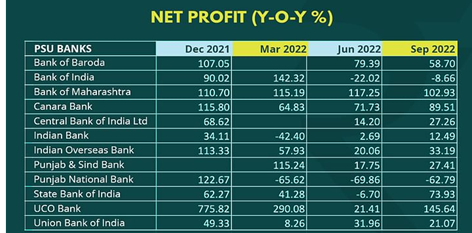

Context
The Public sector banks (PSBs) have reported remarkable growth in the July-September quarter of the year 2022.
Key points:
- Profits increased: The asset quality of PSBs has improved, their profits have increased and they have recorded an impressive pace of credit growth in the July-September quarter.
- Better stock market performance: The performance of PSBs is also getting reflected in the stock market performance of banks.
- Improved Asset quality: It is measured as Gross Non-Performing Assets as a percentage of total advances (GNPA ratio) have seen a sustained improvement.
- As an example, Canara Bank’s GNPA ratio has fallen from 7.80 percent in December 2021, to 6.37 percent in September 2022.
- Union Bank of India’s GNPA ratio has declined from 11.6 percent in December 2021, to 8.45 percent in September 2022.
- Reduction in GNPAs can be explained by better recoveries.
- Better Borrowing rates: Borrowers who availed of the Emergency Credit Line Guarantee Scheme (ECLGS) — a scheme to help borrowers tide over the challenges posed by the pandemic by providing a 100 percent guarantee to lenders have exhibited good repayment behavior.

What are the reasons for public sector banks making Profits?
- Due to the rise in loans including housing and corporate loans.
- Interest income, which includes interest on advances and interest on investment, has seen a sharp growth.
- While banks have been able to pass on higher rates to borrowers. This has boosted the net interest margins of banks.
- Clean-up of stressed assets, better regulation, pick-up in loans, and an improvement in corporate credit demand are driving the profitability of public sector banks.
Impacts:
|
On Customers |
On Banks |
|
|
Concerns associated:
- The exploitation of customers by Banks using more market demand of their banks.
- An increase in loans by customers can increase the risk of more defaults in the future due to economic downfalls and other situations like the Pandemic.
- Lack of market stabilisation strategy by banks can lead to future reductions in the funds of banks.


